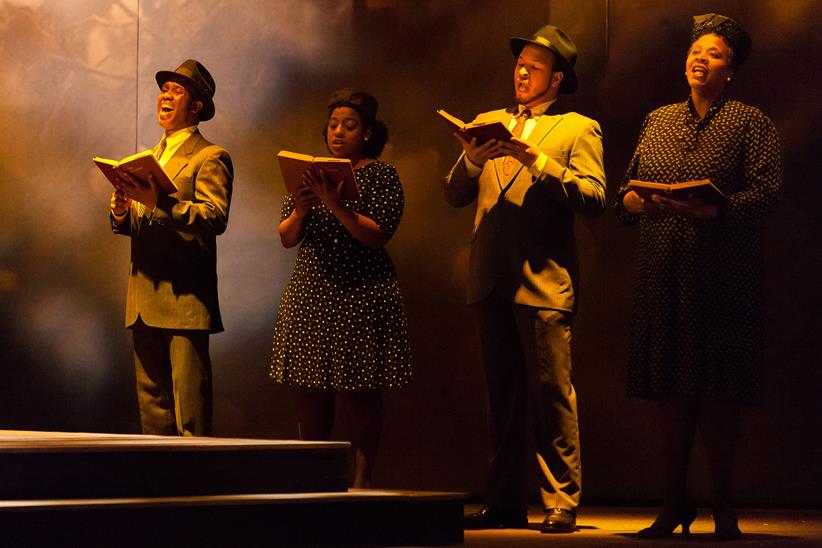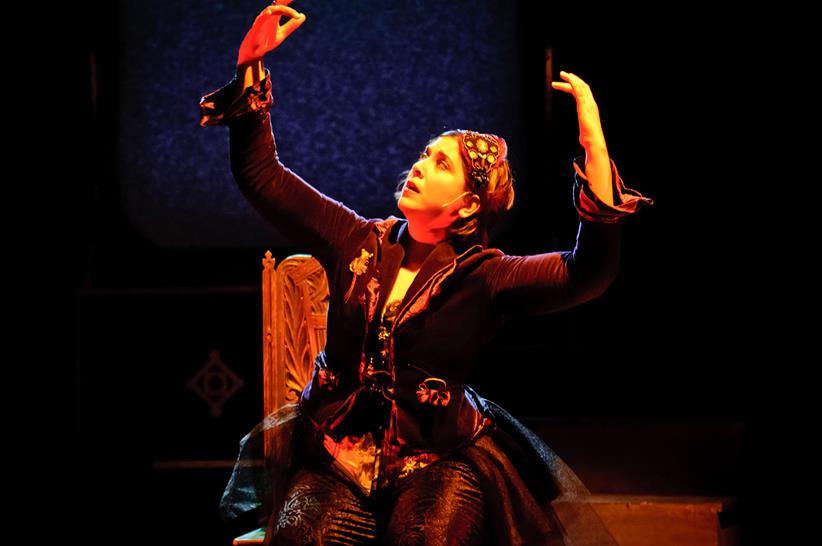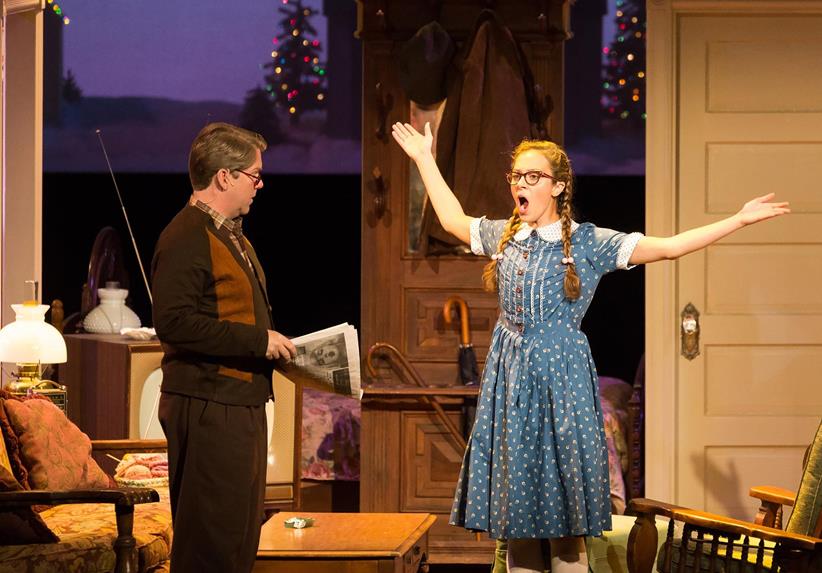Sound Decisions
Amplification: Is it a scourge? Or a harbinger of the future?

Mention bringing electronic sound equipment into the opera house to amplify, lightly reinforce or enhance the traditional opera experience, and it prompts an almost verbatim refrain from many administrators, composers, sound designers and music directors: Opera’s majesty derives from the fantastical power of the unamplified voice to project through a hall. In a 1999 op-ed, shortly after the disclosure by Lincoln Center that its New York State Theater would be fitted with an amplification system, Chicago Tribune music critic John von Rhein wrote that “the time is now for art to stand up to science and defend its integrity against the potential abuses of ‘sound enhancement.’” And Marilyn Horne has called amplification the “kiss of death for good singing.”
But much of the opera community is moving beyond this form of purism. Amplification is increasingly becoming a necessity, especially in alternative, acoustically-challenged spaces. More composers, too, are writing with amplification in mind, with the result that more singers are engaging with the technology. “I think conservative opera-lovers get nervous at the thought of amplification as a technical modification of what they love the most: the unamplified voice in an acoustically perfect space,” the director Yuval Sharon wrote in the compendium Opera: Passion, Power and Politics. “But why subject all future operas to the same conditions? ... I believe most strongly in opera’s future when I see composers and librettists integrate the latest technology directly into the work they’re writing.”
Still, not all antipathy toward amplification is unjustified, as sound designer and composer Mark Grey admits. “Singers can be projected in a way that, out of the gate, the audience knows it’s going to be are inforced show,” says Grey, noting that overly aggressive amplification is a common mistake made by his peers, especially those bringing a musical-theater sensibility to the opera house. Instead, Grey strives to make his work unnoticeable. He considers himself a type of performer, one who must pay attention to the colors of the voices, the timbre of the orchestra and the acoustics of the room itself to create a perfect, unobtrusive balance. “What I create is a kind of hyperreality,” he explains. “For example, in the back rows of a big house, you get the distance effect. If someone coughs next to you, it’s five times louder to your ears than what’s coming from the stage. Your ears acclimatize very quickly, and audio technology can extend the transparency of the stage to those last seats so they still feel really connected to the sound coming from there.”
“You see what’s the minimum amount you can do just to pick up on the things you’d like to hear a bit more and clarify the spectrum of sound,” says Ian Dearden of the London-based sound design firm Sound Intermedia. “In a great hall, this is what the acoustic does for you, but unconventional spaces can often destroy what you want or accentuate what you don’t want. People in the orchestra pit don’t need me rebalancing them, but I can be a good colleague by helping what they’re doing speak with more clarity — like helping the upper particles of the strings, for instance. It’s about getting involved but remaining invisible.”
Regardless of how concealed the sound designer may be from the audience, the singers are always aware of their interventions. That has prompted another major fear: that a shift toward microphones will engender a change in how classical singing is taught. “People have valid concerns in the opera world that we don’t want to affect people’s technique,” comments countertenor Anthony Roth Costanzo, who has used amplification in numerous contexts, most notably to achieve the spectral effects required in Kaija Saariaho’s Only the Sound Remains. “Broadway, for example, has become over-amplified, and that has had an effect on people’s singing overtime. [But when amplification is used in opera,] singers are often undermiked, and that can make you feel like you need to give more. You wind up with more problematic acoustics than you had previously. That’s why it’s important to have a designer artful enough to create an experience for the singers to sound good, singing with our own technique.”

Many seminal recent works have been written explicitly for amplification — a trend that started three decades ago, with John Adams’ Nixon in China, and has continued in the work of composers like David T. Little and Kamala Sankaram. Beth Morrison, whose Beth Morrison Projects has premiered over 50 works using amplification, sees the technology as a way of expanding the materials that composers have at their command. “This is where composers are going, and we need to go with them,” she argues. “Neither [amplified nor acoustic] is better or worse. It simply just is. Whatever composers are hearing in their heads is the sound we should be producing, and I don’t know why, as a field, we have to put some kind of judgment on this.”
“For me, the choice of whether a piece is amplified comes down to the story I’m telling,” says David T. Little. “In the case of two of my operas, Soldier Songs and Dog Days, electricity, machinery, and literal and metaphoric explosions are part of the storytelling’s sound world. Using completely acoustic means to tell those stories doesn’t make sense. We have the technology, so why not use it?”
Little argues that amplification is an effective way of reaching the ears of younger operagoers. “If you’re used to going to rock concerts, the sound of an orchestra can lack impact,” he says. “But the subwoofers [in my operas] make you feel like you would at a rock show, which connects audience members with other experiences they may have had.”
“We’re all used to having earphones in,” says Michael Smallwood, vice president and technical director at Lyric Opera of Chicago. “We listen differently, so perhaps the natural voice in an acoustic environment isn’t going to keep people’s attention, and opera might have to sound different. Not to take away from performers’ skill, but if there’s a way to supplement them and enhance the show, that might be a good thing.” Kamala Sankaram values the extended sonic palate that amplification offers her. But she also sees the technology as a democratizing force. “Opera, with its big gilded houses, is seen as an elitist institution,” she says. “If you do it in a warehouse in the middle of a community and it’s easy for people to get to, a barrier is removed and people are more likely to come.” Amplification, Sankaram points out, can make easily accessible venues into viable spaces for operatic performance.
Although Ricky Ian Gordon doesn’t compose specifically with amplification in mind, he is more than willing to use it on an as-needed basis. “If you’re writing a commission for four different companies, each house is going to have a different acoustic,” he says. “My work requires singers to act in a truthful and intimate way. When you’re in the part of the voice that doesn’t soar over the orchestra, a little amplification often helps.” At the workshop for A Coffin in Egypt, the chorus consisted of four gospel soloists, but at the work’s 2014 Houston Grand Opera premiere, four choral singers took the parts, necessitating an electronic boost. Intimate Apparel, a work that Gordon is writing for the Metropolitan Opera/Lincoln Center Theater commissioning program, is scheduled to bow at Lincoln Center’s Vivian Beaumont Theater: a venue that mikes all of its offerings.

“Frankly, I’m grateful for electricity,” Gordon says. “It’s hard enough to just write an opera — you really just want it to be heard. The sound designers are my favorite people in the room because I know they’re going to help me and my piece.”
Without question, amplification adds a budget line that you won’t find in the ledger for an acoustic show. Morrison estimates the additional costs at $5,000 to $10,000 per production. “But I don’t think about it anymore,” she says. “It’s just a line item.” In fact, most theaters are already equipped with some form of sound equipment, a factor that represents potential savings. Mark Grey, for one, prefers to work primarily with what is on hand rather than gut a house, as a Broadway sound designer might. “To work within the means of opera companies is to work with them and not against them,” he says.
It can be argued that long before electronics, opera used scientific knowledge in the form of architecture to enhance sound. Yuval Sharon has described the Bayreuth Festspielhaus as a venue “where Wagner employed pre-electrified amplification — or, more simply, put, architecture — to create a new sonic world.” LA Opera, which puts a high priority on “the foundation of the unamplified voice,” according to its president and CEO, Christopher Koelsch, employs an acoustical cloud over the Dorothy Chandler Pavilion stage for some chamber works, enhancing the sound through non-electronic means.
No matter how you view it as an aesthetic force in opera, there’s no question that amplification is here to stay. “Opera is a multidisciplinary art form,” Anthony Roth Costanzo argues, noting that the form has incorporated innovations in dance and design since its inception. “One of the disciplines incorporated into opera today is technology,” he says, “and along with that goes amplification.”

Talk Therapy
A look at Opera Theatre of Saint Louis’ 2017 production of Regina in which the lead singers wore mics.
This article was published in the Fall 2018 issue of Opera America Magazine.

Charles Shafaieh
Charles Shafaieh is an arts writer based in New York City. His work has appeared in The New Yorker, Opera News, and other publications.





